Influence of Using Waste Plastic and/or Recycled Rubber as Coarse Aggregates on the Performance of Pervious Concrete
Abstract
1. Introduction
2. Materials and Methods
2.1. Material
2.2. Mix Design, Preparation of Samples, and Curing
2.3. Testing
3. Results and Discussion
3.1. Infiltration Rate
3.2. Compressive Strength
4. Conclusions
- Using waste plastic and/or recycled rubber as concrete aggregates significantly decreases the compressive strength of concrete for all level of replacement. 85% 82%, and 85% of compressive strength was lost with 25% replacement with waste plastic, recycled rubber, and a combination of both, respectively.
- The permeability of concrete contains waste plastic and/or recycled rubber increased with the increase of the replacement level. Replacing 25% of natural coarse aggregates with waste plastic, recycled rubber, and a combination of both increases the permeability values by 83%, 3%, and 68%, respectively.
Author Contributions
Funding
Conflicts of Interest
References
- Pierrehumbert, R. There is no Plan B for dealing with the climate crisis. Bull. At. Sci. 2019, 75, 215–221. [Google Scholar] [CrossRef]
- Kushner, J. The Life and Death of Great Cities in the Time of Climate Change. J. Comp. Urban Law Policy 2020, 4, 133–217. [Google Scholar]
- Saintilan, N.; Khan, N.S.; Ashe, E.; Kelleway, J.J.; Rogers, K.; Woodroffe, C.D.; Horton, B.P. Thresholds of mangrove survival under rapid sea level rise. Science 2020, 368, 1118–1121. [Google Scholar] [CrossRef]
- O’Donnell, E.C.; Thorne, C.R. Drivers of future urban flood risk. Philos. Trans. R. Soc. A Math. Phys. Eng. Sci. 2020, 378, 20190216. [Google Scholar] [CrossRef]
- Available online: https://eciu.net/analysis/briefings/climate-impacts/flood-risk-and-the-uk (accessed on 22 October 2020).
- Imran, H.; Akib, S.; Karim, M.R. Permeable pavement and stormwater management systems: A review. Environ. Technol. 2013, 34, 2649–2656. [Google Scholar] [CrossRef]
- Sonebi, M.; Bassuoni, M. Investigating the effect of mixture design parameters on pervious concrete by statistical modelling. Constr. Build. Mater. 2013, 38, 147–154. [Google Scholar] [CrossRef]
- Sonebi, M.; Bassuoni, M.; Yahia, A. Pervious Concrete: Mix Design, Properties and Applications. RILEM Tech. Lett. 2016, 1, 109. [Google Scholar] [CrossRef]
- Ahmed, T.; Hoque, S. Study on pervious concrete pavement mix designs. In IOP Conference Series: Earth and Environmental Science; IOP Publishing: Kedah, Malaysia, 2020; Volume 476, p. 012062. [Google Scholar]
- Mahalingam, R.; Mahalingam, S.V. Analysis of pervious concrete properties. Građevinar 2016, 68, 493–501. [Google Scholar]
- Kia, A.; Wong, H.S.; Cheeseman, C.R. Clogging in permeable concrete: A review. J. Environ. Manag. 2017, 193, 221–233. [Google Scholar] [CrossRef]
- Coughlin, J.P.; Campbell, C.D.; Mays, D.C. Infiltration and Clogging by Sand and Clay in a Pervious Concrete Pavement System. J. Hydrol. Eng. 2012, 17, 68–73. [Google Scholar] [CrossRef]
- Available online: https://ourworldindata.org/plastic-pollution (accessed on 22 October 2020).
- Available online: http://datatopics.worldbank.org/what-a-waste/tackling_increasing_plastic_waste.html (accessed on 22 October 2020).
- Li, Y.; Zhang, S.; Wang, R.; Dang, F. Potential use of waste tire rubber as aggregate in cement concrete—A comprehensive review. Constr. Build. Mater. 2019, 225, 1183–1201. [Google Scholar] [CrossRef]
- LeBlanc, R. How Long does It Take Garbage to Decompose? The Balance. 2017. Available online: www.thebalance.Com/how-long-does-it-take-garbage-to-decompose-2878033 (accessed on 22 October 2020).
- Stafford, R.; Jones, P.J. Viewpoint—Ocean plastic pollution: A convenient but distracting truth? Mar. Policy 2019, 103, 187–191. [Google Scholar] [CrossRef]
- Hansen, T.C. (Ed.) Recycling of Demolished Concrete and Masonry; CRC Press: Boca Raton, FL, USA, 1992. [Google Scholar]
- Nováková, I.; Mikulica, K. Properties of Concrete with Partial Replacement of Natural Aggregate by Recycled Concrete Aggregates from Precast Production. Procedia Eng. 2016, 151, 360–367. [Google Scholar] [CrossRef]
- Evangelista, L.; De Brito, J. Mechanical behaviour of concrete made with fine recycled concrete aggregates. Cem. Concr. Compos. 2007, 29, 397–401. [Google Scholar] [CrossRef]
- Aly, A.M.; El-Feky, M.; Kohail, M.; Nasr, E.-S.A. Performance of geopolymer concrete containing recycled rubber. Constr. Build. Mater. 2019, 207, 136–144. [Google Scholar] [CrossRef]
- Abdelmonem, A.; El-Feky, M.; Nasr, E.-S.A.; Kohail, M. Performance of high strength concrete containing recycled rubber. Constr. Build. Mater. 2019, 227, 116660. [Google Scholar] [CrossRef]
- Sofi, A. Effect of waste tyre rubber on mechanical and durability properties of concrete – A review. Ain Shams Eng. J. 2018, 9, 2691–2700. [Google Scholar] [CrossRef]
- Park, J.; Lee, B.C.; Kim, J.H. Studies on mechanical properties of concrete containing waste glass aggregate. Cem. Concr. Res. 2004, 34, 2181–2189. [Google Scholar] [CrossRef]
- Jin, W.; Meyer, C.; Baxter, S. “Glascrete”-Concrete with Glass Aggregate. ACI Mater. J. 2000, 97, 208–213. [Google Scholar]
- Chunlin, L.; Kunpeng, Z.; Depeng, C. Possibility of Concrete Prepared with Steel Slag as Fine and Coarse Aggregates: A Preliminary Study. Procedia Eng. 2011, 24, 412–416. [Google Scholar] [CrossRef]
- Nadeem, M.; Pofale, A.D. Utilization of Industrial Waste Slag as Aggregate in Concrete Applications by Adopting Taguchi’s Approach for Optimization. Open J. Civ. Eng. 2012, 2, 96–105. [Google Scholar] [CrossRef]
- Chinnaraju, K.; Ramkumar, V.R.; Lineesh, K.; Nithya, S.; Sathish, V. Study on concrete using steel slag as coarse aggregate replacement and ecosand as fine aggregate replacement. IJREAT Int. J. Res. Eng. Adv. Technol. 2013, 1, 65–69. [Google Scholar]
- El-Tair, A.M.; Bakheet, R.; El-Feky, M.S.; Kohail, M.; Akib, S. Utilization of Water-Cooled and Air-Cooled Slag Aggregate in Concrete: A Solution to the Secular Economy. Eng. Adv. Eng. 2020, 1, 48–59. [Google Scholar] [CrossRef]
- Jeevitha, B.; Urs, N. Study on Mechanical Properties of Cement Concrete for Partial Replacement of Coarse Aggregate by Shredded Plastic and Cement by Fly Ash and Metakaolin. In Sustainable Construction and Building Materials; Springer: Singapore, 2019; pp. 177–187. [Google Scholar]
- Hama, S.M.; Hilal, N.N. Fresh properties of concrete containing plastic aggregate. In Use of Recycled Plastics in Eco-efficient Concrete; Woodhead Publishing: Cambridge, UK, 2019; pp. 85–114. [Google Scholar]
- Mohammed, A. Mechanical strength of concrete with PVC aggregates. In Use of Recycled Plastics in Eco-efficient Concrete; Woodhead Publishing: Cambridge, UK, 2019; pp. 115–135. [Google Scholar]
- Koide, H.; Tomon, M.; Sasaki, T. Investigation of the use of waste plastic as an aggregate for lightweight concrete. In Challenges of Concrete Construction: Volume 5, Sustainable Concrete Construction, Proceedings of the International Conference held at the University of Dundee, Scotland, UK, 9–11 September 2002; Thomas Telford Publishing: London, UK, 2002; Volume 5, pp. 177–185. [Google Scholar]
- Saikia, N.; De Brito, J. Use of plastic waste as aggregate in cement mortar and concrete preparation: A review. Constr. Build. Mater. 2012, 34, 385–401. [Google Scholar] [CrossRef]
- Mohammed, A.A.; Mohammed, I.I.; Mohammed, S.A. Some properties of concrete with plastic aggregate derived from shredded PVC sheets. Constr. Build. Mater. 2019, 201, 232–245. [Google Scholar] [CrossRef]
- Jaivignesh, B.; Sofi, A. Study on Mechanical Properties of Concrete Using Plastic Waste as an Aggregate. In IOP Conference Series: Earth and Environmental Science; IOP Publishing: Thanjavur, India, 2017; Volume 80, p. 012016. [Google Scholar]
- Khalil, W.I.; Mahdi, H.M. Some properties of sustainable concrete with mixed plastic waste aggregate. IOP Conf. Series Mater. Sci. Eng. 2020, 737, 012073. [Google Scholar] [CrossRef]
- Krasna, W.A.; Noor, R.; Ramadani, D.D. Utilization of Plastic Waste Polyethylene Terephthalate (Pet) as a Coarse Aggregate Alternative in Paving Block. In Proceedings of the MATEC Web of Conferences, Banjarmasin, Indonesia, 11–12 October 2018; EDP Sciences: Les Ulis, France, 2019; Volume 280, p. 04007. [Google Scholar]
- Rahim, N.L.; Sallehuddin, S.; Ibrahim, N.M.; Amat, R.C.; Ab Jalil, M.F. Use of Plastic Waste (High Density Polyethylene) in Concrete Mixture as Aggregate Replacement. Adv. Mater. Res. 2013, 701, 265–269. [Google Scholar] [CrossRef]
- Choi, Y.-W.; Moon, D.-J.; Chung, J.-S.; Cho, S.-K. Effects of waste PET bottles aggregate on the properties of concrete. Cem. Concr. Res. 2005, 35, 776–781. [Google Scholar] [CrossRef]
- Marzouk, O.Y.; Dheilly, R.; Quéneudéc, M. Valorization of post-consumer waste plastic in cementitious concrete composites. Waste Manag. 2007, 27, 310–318. [Google Scholar] [CrossRef]
- Kou, S.; Lee, G.; Poon, C.; Lai, W. Properties of lightweight aggregate concrete prepared with PVC granules derived from scraped PVC pipes. Waste Manag. 2009, 29, 621–628. [Google Scholar] [CrossRef]
- Panyakapo, P.; Panyakapo, M. Reuse of thermosetting plastic waste for lightweight concrete. Waste Manag. 2008, 28, 1581–1588. [Google Scholar] [CrossRef]
- Ismail, Z.Z.; Al-Hashmi, E.A. Use of waste plastic in concrete mixture as aggregate replacement. Waste Manag. 2008, 28, 2041–2047. [Google Scholar] [CrossRef]
- Kan, A.; Demirboğa, R. A novel material for lightweight concrete production. Cem. Concr. Compos. 2009, 31, 489–495. [Google Scholar] [CrossRef]
- Kumar, S.; Gupta, R.C.; Thomas, B.S.; Mehra, P.; Charytonowicz, J. Aggregate Replacement and Its Usefulness in Cement Concrete for Sustainable Development—A Study on Rubber, Jarosite and Sandstone Aggregates. In Advances in Intelligent Systems and Computing; Springer: Cham, Switzerland, 2016; Volume 493, pp. 13–25. [Google Scholar]
- Liu, H.; Luo, G.; Gong, Y.; Wei, H. Mechanical Properties, Permeability, and Freeze–Thaw Resistance of Pervious Concrete Modified by Waste Crumb Rubbers. Appl. Sci. 2018, 8, 1843. [Google Scholar] [CrossRef]
- Ganjian, E.; Khorami, M.; Maghsoudi, A.A. Scrap-tyre-rubber replacement for aggregate and filler in concrete. Constr. Build. Mater. 2009, 23, 1828–1836. [Google Scholar] [CrossRef]
- ASTM International. Standard Specification for Portland Cement ASTM International; C150/C150M-19a; ASTM International: West Conshohocken, PA, USA, 2019. [Google Scholar]
- ASTM International. Standard Test Method for Compressive Strength of Cylindrical Concrete Specimens; C39/C39M-20; ASTM International: West Conshohocken, PA, USA, 2020. [Google Scholar]
- ASTM International. Standard Test Method for Infiltration Rate of in Place Pervious Concrete; C1701/C 1701M-09; ASTM International: West Conshohocken, PA, USA, 2009. [Google Scholar]
- Khalil, W.; Al Obeidy, N. Some properties of sustainable concrete containing two environmental wastes. In Proceedings of the MATEC Web of Conferences, Sharm el-Shiekh, Egypt, 23–25 October 2017; EDP Sciences: Paris, France, 2018; Volume 162, p. 02029. [Google Scholar]
- Najim, K.B.; Hall, M.R. Crumb rubber aggregate coatings/pre-treatments and their effects on interfacial bonding, air entrapment and fracture toughness in self-compacting rubberised concrete (SCRC). Mater. Struct. 2013, 46, 2029–2043. [Google Scholar] [CrossRef]
- Suleiman, M.T.; Kevern, J.; Schaefer, V.R.; Wang, K. Effect of compaction energy on pervious concrete properties. In Submitted to Concrete Technology Forum-Focus on Pervious Concrete; National Ready Mix Concrete Association: Nashville, TN, USA, 2006; pp. 23–25. [Google Scholar]
- Pezzi, L.; De Luca, P.A.; Vuono, D.; Chiappetta, F.; Nastro, A. Concrete products with waste’s plastic material (bottle, glass, plate). In Materials Science Forum; Trans Tech Publications Ltd.: Zürich, Switzerland, 2006; Volume 514, p. 1753. [Google Scholar]
- Hameed, A.M.; Ahmed, B.A.F. Employment the plastic waste to produce the light weight concrete. Energy Procedia 2019, 157, 30–38. [Google Scholar] [CrossRef]
- Bamforth, P.B. The water permeability of concrete and its relationship with strength. Mag. Concr. Res. 1991, 43, 233–241. [Google Scholar] [CrossRef]
- Li, L.G.; Feng, J.J.; Zhu, J.; Chu, S.; Kwan, A.K.H. Pervious concrete: Effects of porosity on permeability and strength. Mag. Concr. Res. 2019, 1–35. [Google Scholar] [CrossRef]
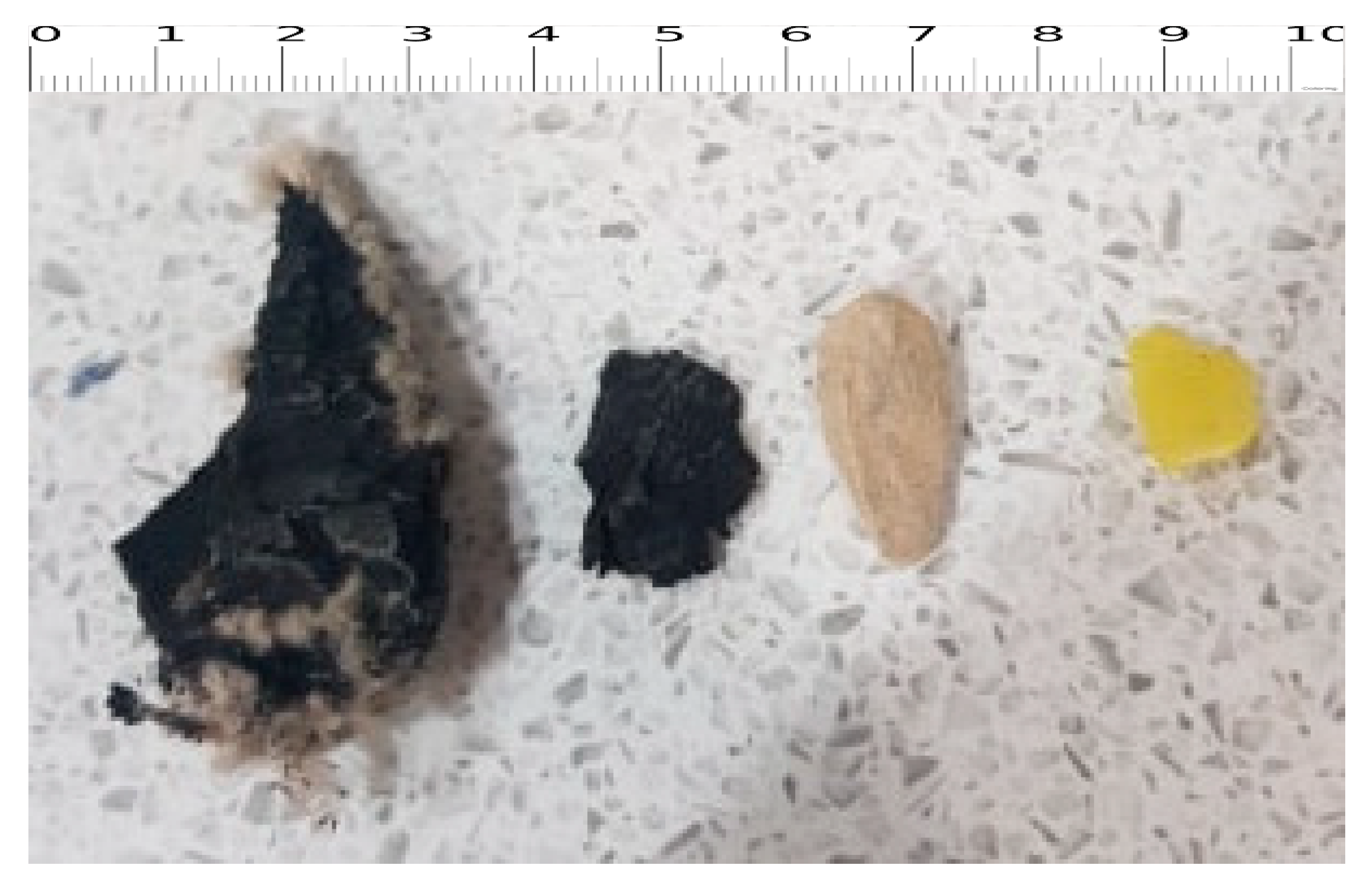
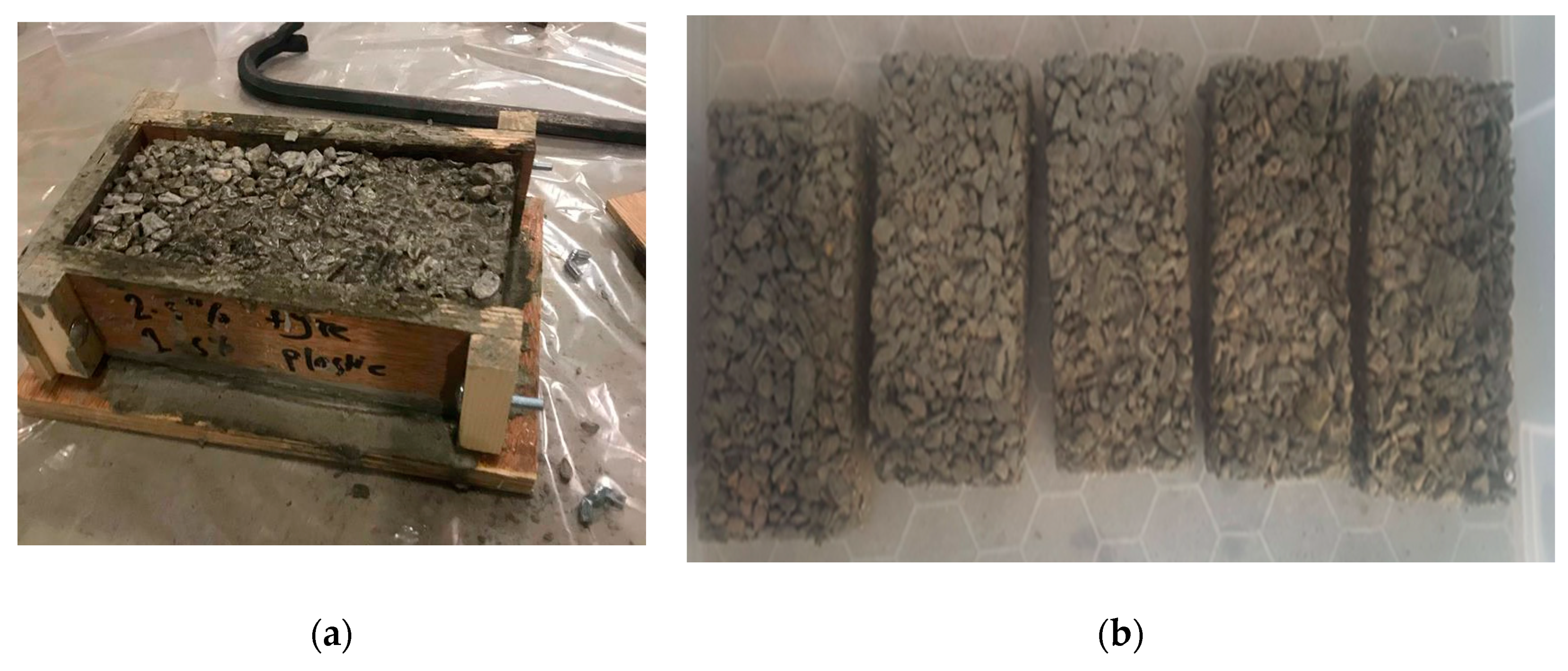
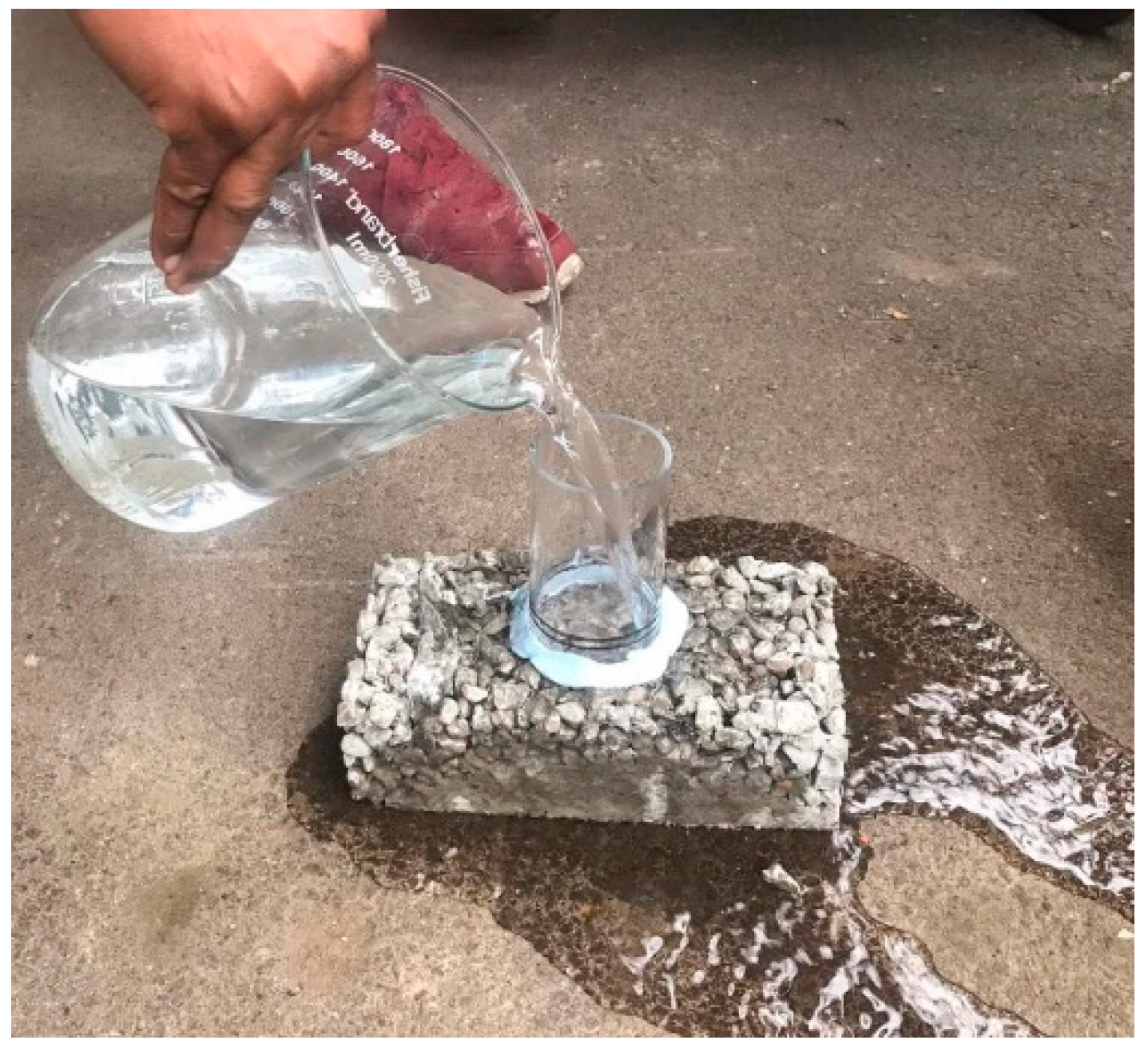
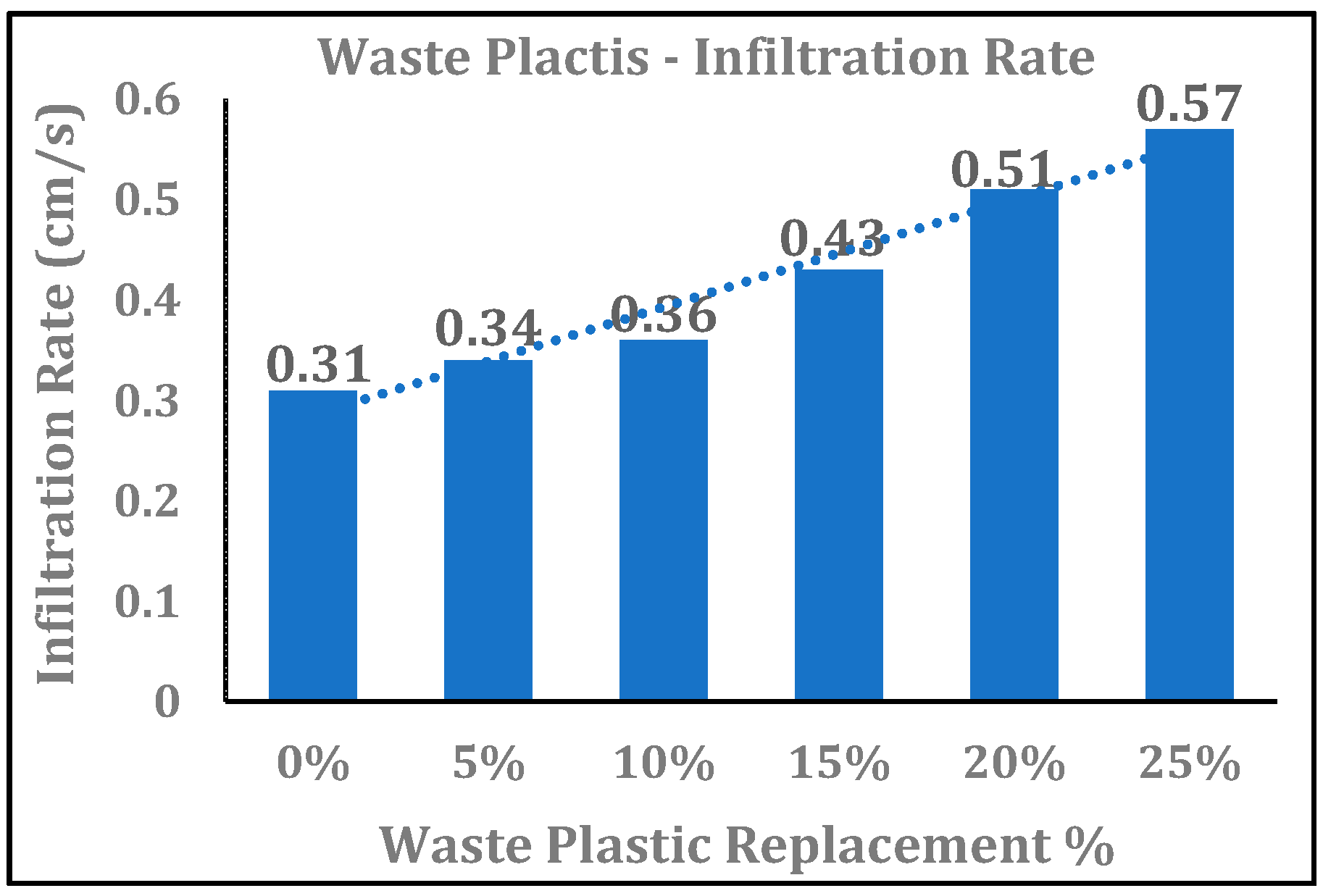
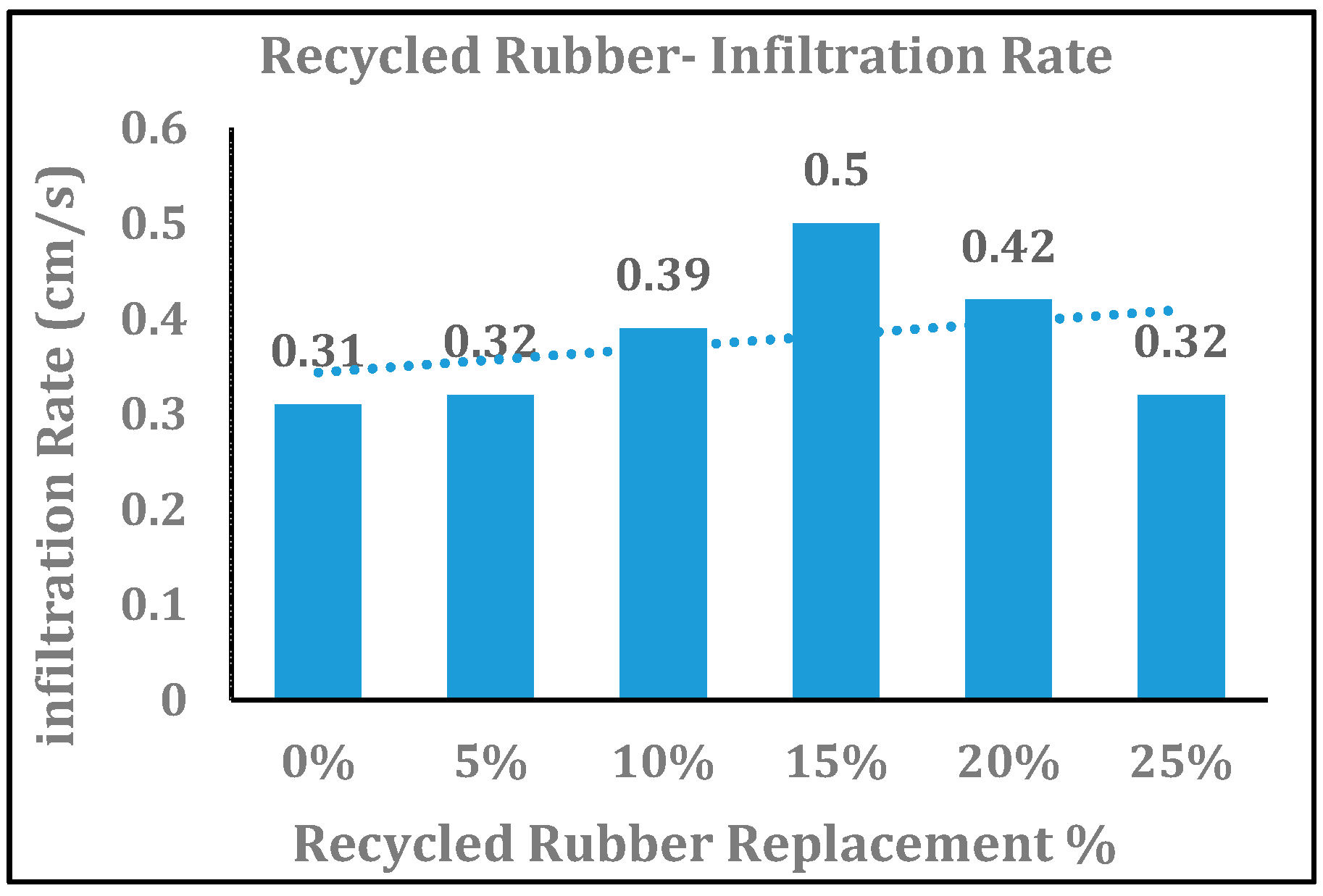
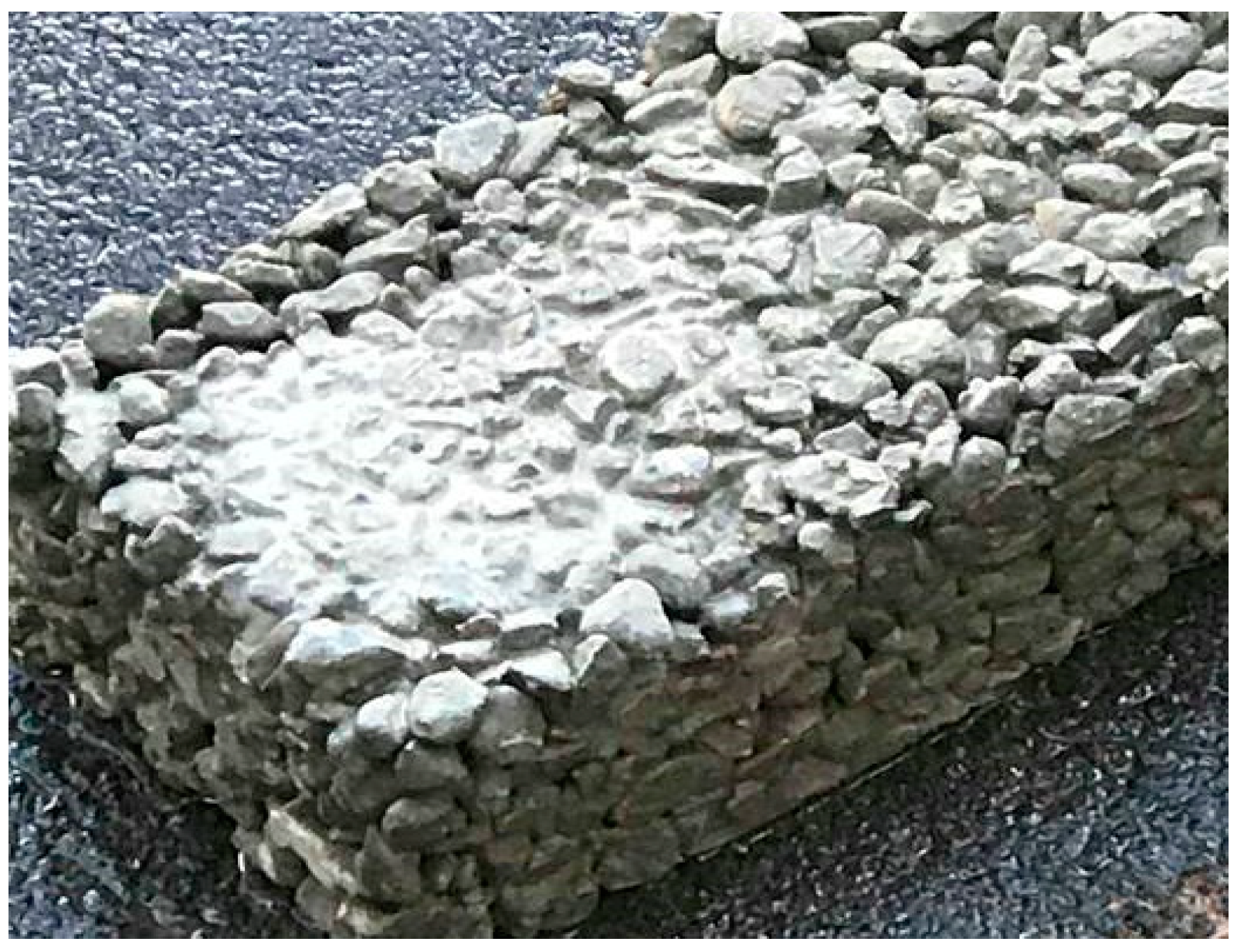
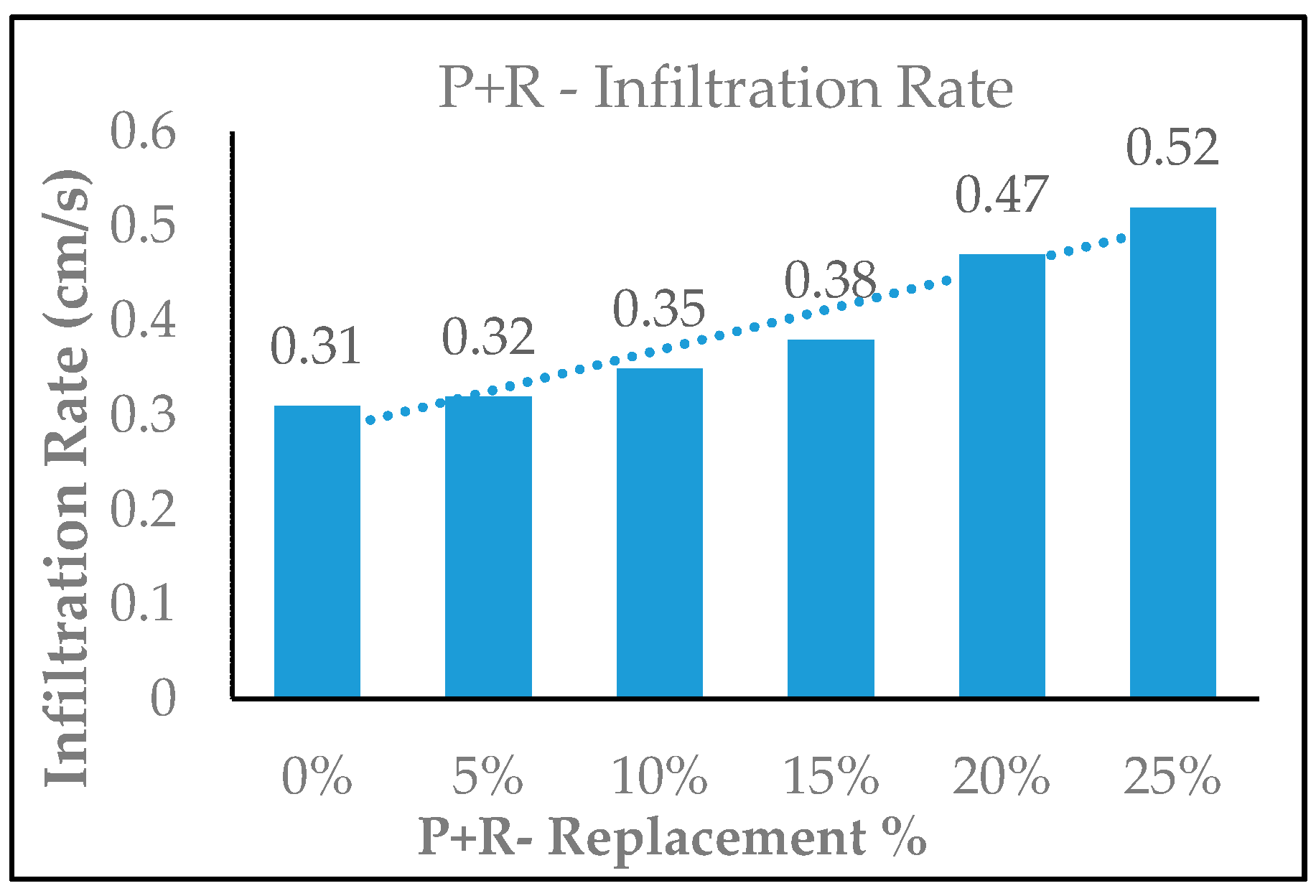
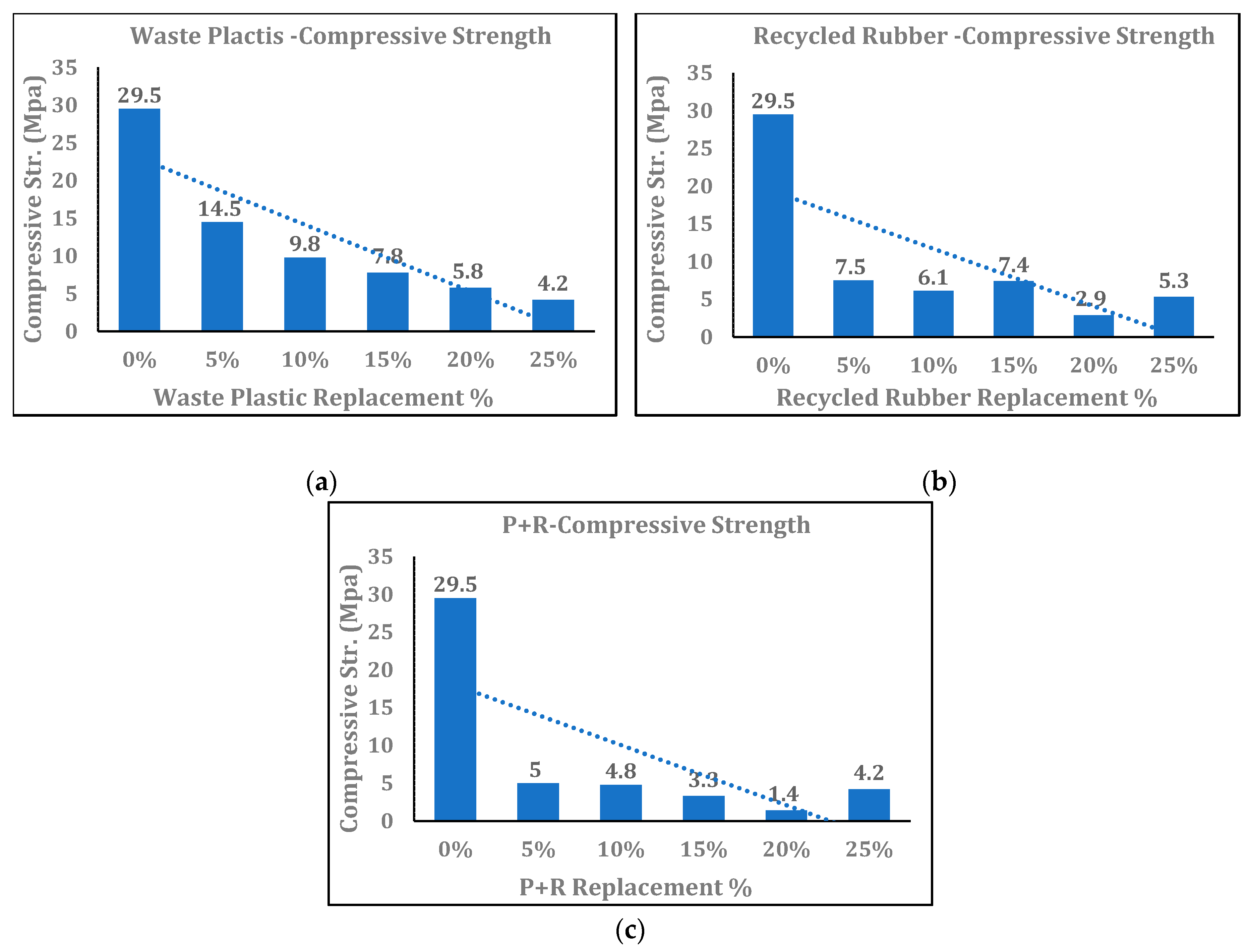
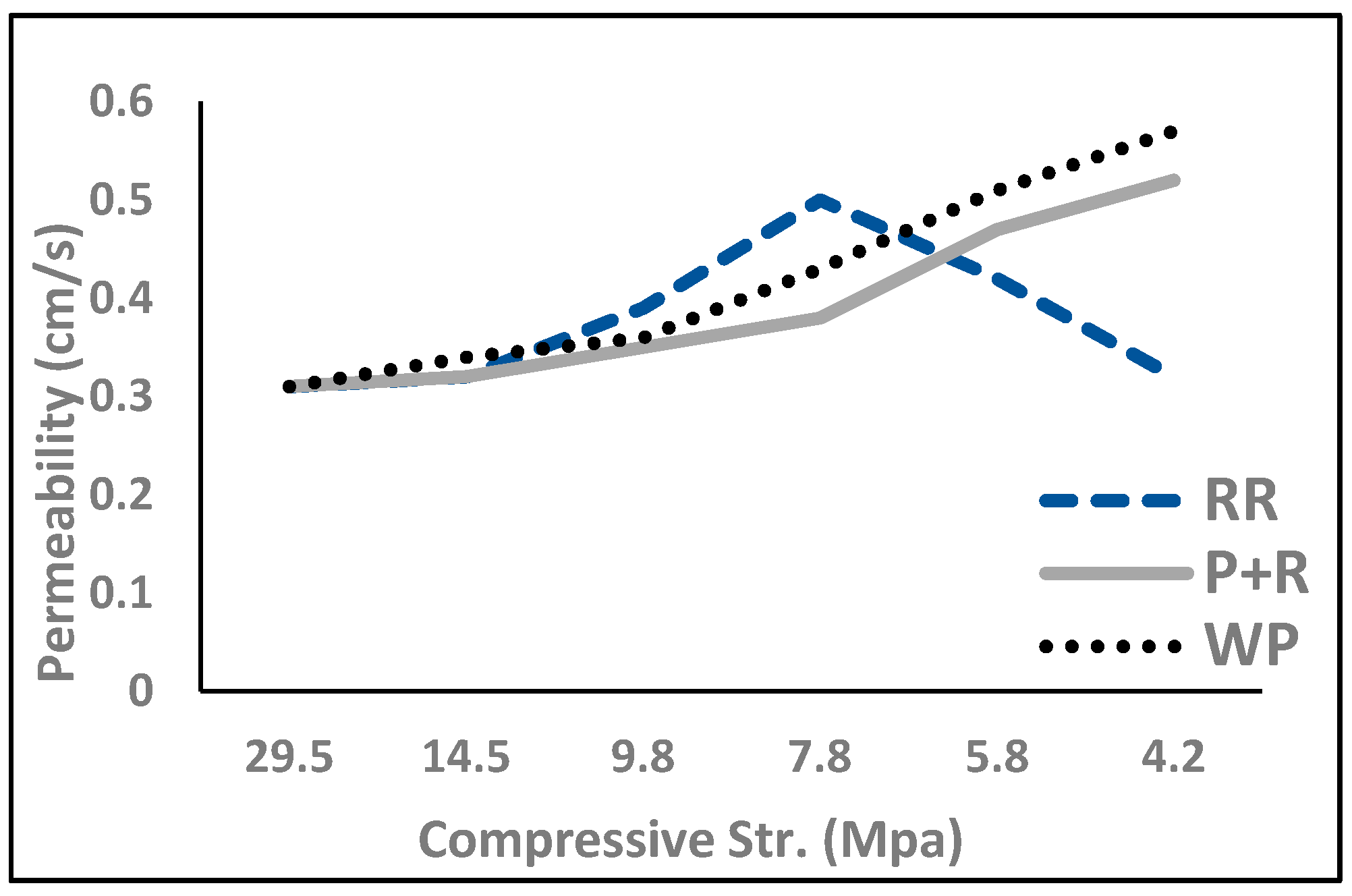
| Constituents | SiO2 | Al2O3 | CaO | Fe2O3 | MgO | Na2O | K2O | SO3 | Ignition Loss |
|---|---|---|---|---|---|---|---|---|---|
| Cement | 20.13% | 5.32% | 61.63% | 3.61% | 2.39% | 0.37% | 0.13% | 2.87% | ≤0.01% |
| Property. | Gravel | Sand | WP | RR |
|---|---|---|---|---|
| Specific Weight | 2.7 | 2.6 | 1.3 | 0.9 |
| Water Absorption (%) | 0.60 | 0.72 | NIL | NIL |
| * NIL = almost zero |
| Mix ID | Waste Plastic % | Recycled Rubber % | Aggregate (kg/m3) | Waste Plastic (kg/m3) | Recycled Rubber (kg/m3) | Cement (kg/m3) | Sand (kg/m3) |
|---|---|---|---|---|---|---|---|
| Control | 0 | 0 | 1515 | 0 | 0 | 290 | 216 |
| WP-05% | 5 | 0 | 1443 | 72 | 0 | 290 | 216 |
| WP-10% | 10 | 0 | 1371 | 144 | 0 | 290 | 216 |
| WP-15% | 15 | 0 | 1299 | 216 | 0 | 290 | 216 |
| WP-20% | 20 | 0 | 1227 | 289 | 0 | 290 | 216 |
| WP-25% | 25 | 0 | 1154 | 361 | 0 | 290 | 216 |
| RR-05% | 0 | 5 | 1443 | 0 | 72 | 290 | 216 |
| RR-10% | 0 | 10 | 1371 | 0 | 144 | 290 | 216 |
| RR-15% | 0 | 15 | 1299 | 0 | 216 | 290 | 216 |
| RR-20% | 0 | 20 | 1227 | 0 | 289 | 290 | 216 |
| RR-25% | 0 | 25 | 1154 | 0 | 361 | 290 | 216 |
| P + R-05% | 2.5 | 2.5 | 1443 | 36 | 36 | 290 | 216 |
| P + R-10% | 5 | 5 | 1371 | 72 | 72 | 290 | 216 |
| P + R-15% | 7.5 | 7.5 | 1299 | 108 | 108 | 290 | 216 |
| P + R-20% | 10 | 10 | 1227 | 144 | 144 | 290 | 216 |
| P + R-25% | 12.5 | 12.5 | 1154 | 180 | 180 | 290 | 216 |
| Mix ID | Waste Plastic % | Mass of Water (kg) | T1 | T2 | T3 | Mean Time (sec) | D2 (mm) * | Infiltration Rate (mm/s) | I (cm/s) |
|---|---|---|---|---|---|---|---|---|---|
| Control | 0 | 3.6 | 51.7 | 52.5 | 48.2 | 50.8 | 2916 | 3.10 | 0.31 |
| WP-5% | 5 | 3.6 | 47.5 | 44.9 | 46.1 | 46.2 | 2916 | 3.41 | 0.34 |
| WP-10% | 10 | 3.6 | 45.6 | 42.3 | 43.5 | 43.8 | 2916 | 3.59 | 0.36 |
| WP-15% | 15 | 3.6 | 35.7 | 35.2 | 38.9 | 36.6 | 2916 | 4.30 | 0.43 |
| WP-20% | 20 | 3.6 | 32.1 | 30.2 | 30.1 | 30.8 | 2916 | 5.11 | 0.51 |
| WP-25% | 25 | 3.6 | 28.2 | 26.5 | 27.4 | 27.4 | 2916 | 5.75 | 0.57 |
| Mix ID | Recycled Rubber % | Mass of Water (kg) | T1 | T2 | T3 | Mean Time (sec) | D2 (mm) * | Infiltration Rate (mm/s) | I (cm/s) |
|---|---|---|---|---|---|---|---|---|---|
| Control | 0 | 3.6 | 51.7 | 52.5 | 48.2 | 50.8 | 2916 | 3.10 | 0.31 |
| RR-05% | 5 | 3.6 | 46.6 | 46 | 55.4 | 49.3 | 2916 | 3.19 | 0.32 |
| RR-10% | 10 | 3.6 | 41.5 | 40.2 | 39.3 | 40.3 | 2916 | 3.90 | 0.39 |
| RR-15% | 15 | 3.6 | 31.5 | 32.6 | 29.6 | 31.2 | 2916 | 5.04 | 0.50 |
| RR-20% | 20 | 3.6 | 37.1 | 35.8 | 39.4 | 37.4 | 2916 | 4.20 | 0.42 |
| RR-25% | 25 | 3.6 | 45.6 | 50.9 | 51.4 | 49.3 | 2916 | 3.19 | 0.32 |
| Mix ID | Recycled Rubber % | Waste Plastic % | Mass of Water (kg) | T1 | T2 | T3 | Mean Time (sec) | D2 (mm) * | Infiltration Rate (mm/s) | I (cm/s) |
|---|---|---|---|---|---|---|---|---|---|---|
| Control | 0 | 0 | 3.6 | 51.7 | 52.5 | 48.2 | 50.8 | 2916 | 3.10 | 0.31 |
| P + R-05% | 2.5 | 2.5 | 3.6 | 50.1 | 47.9 | 49.1 | 49 | 2916 | 3.19 | 0.32 |
| P + R-10% | 5 | 5 | 3.6 | 46.9 | 44.2 | 45.4 | 45.5 | 2916 | 3.90 | 0.35 |
| P + R-15% | 7.5 | 7.5 | 3.6 | 38.9 | 44 | 41 | 41.3 | 2916 | 5.04 | 0.38 |
| P + R-20% | 10 | 10 | 3.6 | 36.5 | 34.7 | 29.5 | 33.6 | 2916 | 4.20 | 0.47 |
| P + R-25% | 12.5 | 12.5 | 3.6 | 28.1 | 30.5 | 31.6 | 30.1 | 2916 | 3.19 | 0.52 |
Publisher’s Note: MDPI stays neutral with regard to jurisdictional claims in published maps and institutional affiliations. |
© 2020 by the authors. Licensee MDPI, Basel, Switzerland. This article is an open access article distributed under the terms and conditions of the Creative Commons Attribution (CC BY) license (http://creativecommons.org/licenses/by/4.0/).
Share and Cite
Cole, L.; Bakheet, R.; Akib, S. Influence of Using Waste Plastic and/or Recycled Rubber as Coarse Aggregates on the Performance of Pervious Concrete. Eng 2020, 1, 153-166. https://doi.org/10.3390/eng1020010
Cole L, Bakheet R, Akib S. Influence of Using Waste Plastic and/or Recycled Rubber as Coarse Aggregates on the Performance of Pervious Concrete. Eng. 2020; 1(2):153-166. https://doi.org/10.3390/eng1020010
Chicago/Turabian StyleCole, Lewis, Ramez Bakheet, and Shatirah Akib. 2020. "Influence of Using Waste Plastic and/or Recycled Rubber as Coarse Aggregates on the Performance of Pervious Concrete" Eng 1, no. 2: 153-166. https://doi.org/10.3390/eng1020010
APA StyleCole, L., Bakheet, R., & Akib, S. (2020). Influence of Using Waste Plastic and/or Recycled Rubber as Coarse Aggregates on the Performance of Pervious Concrete. Eng, 1(2), 153-166. https://doi.org/10.3390/eng1020010






